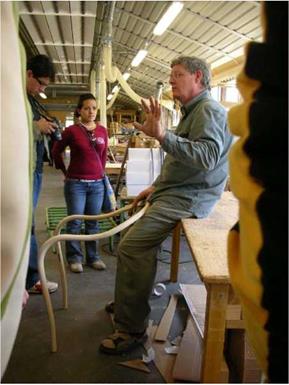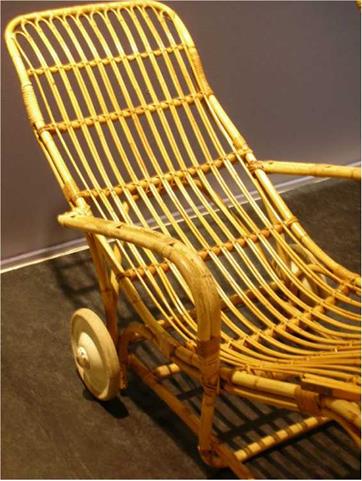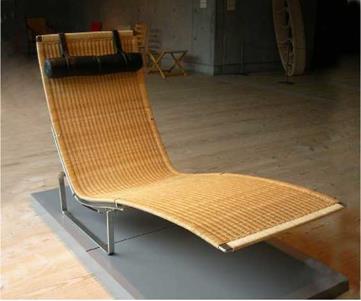 Precompressed wood is a method of forming wood three-dimensionally. The process uses regular lumber that is steamed until the wood is plasticized. Then it is placed in a compressor, which is a solid chamber. Enormous pressure is applied along the longitudinal direction of the wood, causing the fibers of the wood to fold. This process destroys the integrity of the cellular structure of the wood and enables it to be remarkably flexible while the wood retains its moisture (Figure 7.61). When fixed in a form, the wood can be dried, either in the air, in an oven, or by exposing it to high-frequency electromagnetic radiation. The steamed wood can then be "worked" for several hours, or it can be wrapped in plastic to retain the moisture and stored for several weeks—still retaining its flexibility. Care must be taken not to store the wood too long because the high moisture will eventually cause it to rot. Though precompressed wood can easily be formed in a large number of compound curves, it is relatively unstable when dried and therefore is limited in use.6 However, for making working prototypes of furniture designs with compound curves, no material is as easy to work with as precompressed wood. The compressors capable of creating compressed wood are expensive and limited in availability.
Precompressed wood is a method of forming wood three-dimensionally. The process uses regular lumber that is steamed until the wood is plasticized. Then it is placed in a compressor, which is a solid chamber. Enormous pressure is applied along the longitudinal direction of the wood, causing the fibers of the wood to fold. This process destroys the integrity of the cellular structure of the wood and enables it to be remarkably flexible while the wood retains its moisture (Figure 7.61). When fixed in a form, the wood can be dried, either in the air, in an oven, or by exposing it to high-frequency electromagnetic radiation. The steamed wood can then be "worked" for several hours, or it can be wrapped in plastic to retain the moisture and stored for several weeks—still retaining its flexibility. Care must be taken not to store the wood too long because the high moisture will eventually cause it to rot. Though precompressed wood can easily be formed in a large number of compound curves, it is relatively unstable when dried and therefore is limited in use.6 However, for making working prototypes of furniture designs with compound curves, no material is as easy to work with as precompressed wood. The compressors capable of creating compressed wood are expensive and limited in availability.
Veneer
Wood veneers date to Egyptian times but became commonplace in the eighteenth century with the ebonite guilds. Veneering is the process of cutting thin layers of wood from a log using a veneer saw. A lathe will produce rotary cut veneers and a vertical knife
wiy produce plain-sliced veneers. Veneers that are kept in sequence Figure 7.61 Soren Pedersen of PP Mobler explaining in batches are called flitches. Rotary-cut veneer is a continuous precompressed lumber to students. Photography by Jim Postell, 2006.
sheet of thin wood cut from a log that is turned on a very large lathe. This produces a continuous sheet with a variegated ripple figure. Plain-sliced, rift, and quartered veneers are cut along the length of the log. Plain-sliced veneer has a variegated wavy figure, typified by arched markings called cathedrals. Quarter-sliced veneer has a straight, even figure.
Pine was used by English and American furniture makers as the carcass material and then covered with walnut or mahogany veneers. Once the thin layers of wood are cut (Figure 7.62), they can be applied to the surface of a substrate material such as MDF with glue, or laminated together to create a curvilinear form (Figure 7.63). In some cases, it is very important to veneer both sides of a panel with the same or similar species of wood veneer. This will help maintain its dimensional stability and minimize warping.
Grasses
A warp of stiff rods, usually made of willow, produces wicker. Other grasses include cane, rattan, reed, and straw. During the Roman Empire, wicker was a popular medium for furniture, as is evident in a number of stone reliefs. By the seventeenth century, wicker chairs were common throughout Europe. Several modernist designers have used wicker in their furniture designs. Ludwig Mies van der Rohe’s bent metal chair MR and the British officer’s Pel chairs incorporated wicker in conjunction with tubular steel. Rattan is a climbing plant, and the harvested part of the plant is cane. Rattan has always been used for producing furniture.
Bamboo is a grass. It has high sustainability. It can grow up to three feet (91 cm) in one month and can be harvested after a year. Generally, bamboo is prepared by laminating thin pieces of bamboo with an adhesive. Commonly utilized as a flooring material because of its resilient quality, and as scaffolding for its strength, bamboo is an excellent material for furniture because it is relatively stable, hard, strong, and light, making it ideal for tables and shelving units (Figure 7.64).
|
|
|
|
|
|
|


Other grasses used in furniture and upholstery include:
■ Jute
■ Hemp
■ Reed
■ Straw
■ Cane
Braided cane seats have been used in many furniture designs, including Hans J. Wegner’s Cow Horn chair (1961) and Poul Kjsrholm’s PK 24 chaise lounge (1965) (Figure 7.65). Today, wheat and rye grasses have been formed into composite sheet goods and have opened up a world of new design possibilities.
ENDNOTES
1. Materials Research Society (MRS), Materials Science and Engineering Web site: The Intute Consortium, 2006. The Materials Science & Engineering Career Resource Center, which is a service of the Minerals, Metals, & Materials Society (The Third Millenium OnLine).
2. Conversation about heat transfer with University of Cincinnati Professor Tom Bible, School of Architecture and Interior Design, May 2006.
3. Jerryll Habegger and Joseph H. Osman, Sourcebook of Modern Furniture, 2nd edition (New York: W. W. Norton, 1997), p. 279.
4. Ernest Joyce, The Encyclopedia of Furniture Making (New York: Sterling, 1987), p. 74.
5. Ibid. p. 1.
6. Concepts in precompressed wood—Erik Krogh, Professor DKDS. Course handout material, prepared by Professor Erik Krogh, Danmarks Designskole.
chapter


